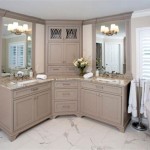How To Make A Bathroom Vanity
Creating a custom bathroom vanity offers the opportunity to tailor the design to precise needs and aesthetic preferences, optimizing space and enhancing the bathroom’s overall style. This article provides a comprehensive guide to constructing a bathroom vanity, covering planning, material selection, assembly, and finishing, ensuring a functional and visually appealing addition to the bathroom.
Planning and Design
The initial stage of vanity construction requires meticulous planning. Accurate measurements of the available space are critical. Consider the width, depth, and height limitations, accounting for plumbing fixtures and door swing clearances. Sketching a detailed design, including the placement of drawers, shelves, and the sink, provides a visual representation of the final product. Determine the desired style, whether it's a freestanding vanity, a wall-mounted unit, or a corner vanity. The design should harmonize with the overall bathroom décor and incorporate functional storage solutions.
Consider the ergonomic aspects of the vanity. The standard height for a bathroom vanity is typically between 30 and 36 inches. Adjust this height based on the users’ needs and preferences. Ensure the sink basin's depth is compatible with the counter height to prevent discomfort during use. Identify the type of sink to be used: under-mount, drop-in, or vessel. Different sink types require different countertop cutouts and installation methods, which must be planned in advance.
Furthermore, consider the plumbing requirements. Accurately locate the water supply lines and drainpipe. The vanity design must accommodate these existing fixtures, allowing for easy access for future maintenance. It's advisable to consult with a plumber during the design phase to address potential complications and ensure compliance with local plumbing codes.
Before proceeding with construction, create a detailed materials list and cutting list. A materials list specifies the required lumber, hardware, and finishing products. A cutting list outlines the dimensions of each piece of lumber needed for the vanity's frame, doors, drawers, and shelves. Precise cutting reduces waste and ensures accurate assembly.
Material Selection and Preparation
The selection of appropriate materials is paramount for durability and aesthetic appeal. Hardwood lumber, such as maple, oak, or cherry, are excellent choices for vanity construction due to their strength and resistance to moisture. Softwoods like pine can be used, but they require thorough sealing and finishing to prevent water damage. Plywood is often used for panels and drawers, offering stability and affordability. When using plywood, opt for a high-quality grade with a smooth veneer surface for optimal finishing.
Consider the moisture resistance of the chosen materials, especially for surfaces near the sink. Marine-grade plywood or MDF (Medium-Density Fiberboard) specifically designed for bathroom applications offer superior moisture resistance compared to standard materials. These materials are less prone to warping, swelling, and delamination in humid environments.
Hardware selection is equally important. Choose high-quality hinges, drawer slides, and handles that are durable and corrosion-resistant. Stainless steel or brass hardware are ideal for bathroom applications. Select drawer slides with appropriate weight capacity to accommodate the intended contents of the drawers. Soft-close hinges and drawer slides add a touch of luxury and prevent slamming.
Proper wood preparation is essential before assembly. Ensure the lumber is properly dried and acclimated to the environment to minimize warping or cracking. Sand all surfaces smooth using progressively finer grits of sandpaper. Start with a coarse grit (e.g., 80-grit) to remove imperfections and gradually move to finer grits (e.g., 120-grit, 220-grit) for a smooth finish. Remove all sanding dust before applying any finish.
For painted finishes, apply a primer to the prepared wood surface. Primer seals the wood, provides a uniform surface for the paint, and improves adhesion. Choose a primer specifically designed for the type of paint being used. For stained finishes, apply a wood conditioner before staining to ensure even color absorption and prevent blotching.
Assembly and Installation
Begin the assembly process by constructing the vanity frame. Use joinery techniques like pocket screws, mortise and tenon joints, or dowel joints to create strong and durable connections. Ensure the frame is square and level before proceeding. Use wood glue in conjunction with mechanical fasteners to reinforce the joints.
Install the side panels, back panel, and bottom panel to the frame. Secure these panels with screws and wood glue. The back panel provides structural support and a surface for attaching the vanity to the wall. The bottom panel supports the weight of the vanity contents. Ensure all panels are flush with the frame and properly aligned.
Construct the drawers using similar joinery techniques as the frame. Assemble the drawer box, ensuring it is square and the runners are properly aligned. Install the drawer slides to the drawer box and the vanity frame. Test the drawer’s operation, ensuring it slides smoothly and closes properly. Install the drawer fronts, aligning them with the adjacent surfaces and securing them with screws.
Install the doors using hinges. Mortise the hinges into the door and the vanity frame, ensuring they are properly aligned. Adjust the hinges to achieve proper door alignment and smooth operation. Install door handles or knobs. Magnetic catches or touch latches can be added to keep the doors securely closed.
Prepare the countertop by cutting the necessary holes for the sink and faucet. Follow the manufacturer's instructions for the sink and faucet installation. Apply a bead of silicone caulk around the rim of the sink before setting it into the countertop. Connect the plumbing fixtures, ensuring all connections are tight and leak-free. Install the countertop onto the vanity frame, securing it with screws or adhesive.
Before final installation, ensure all surfaces are clean and free of debris. Level the vanity using shims if necessary. Secure the vanity to the wall studs using screws. Conceal the screws with wood putty or decorative caps. Apply caulk to seal the gap between the vanity and the wall, preventing water damage. Carefully inspect all components and ensure they are functioning correctly.
Finally, install the chosen hardware like handles and knobs on the drawers and doors. Test the soft-close mechanisms of the hinges and drawer slides, ensuring they operate smoothly and quietly. Re-inspect all plumbing connections for leaks. Clean the finished vanity thoroughly to remove any dust or debris. The final product should be a functional and aesthetically pleasing addition to the bathroom.
:max_bytes(150000):strip_icc()/build-something-diy-vanity-594402125f9b58d58ae21158.jpg?strip=all)
16 Diy Bathroom Vanity Plans You Can Build Today

Build Your Own Bathroom Vanity Fine Homebuilding

How To Build A Diy Bathroom Vanity Angela Marie Made

Diy Bathroom Vanity 12 Rehabs Bob Vila

How To Build A 60 Diy Bathroom Vanity From Scratch

Diy Bathroom Vanity Stacy Risenmay

Diy Bathroom Vanity Ideas

Diy Wood Vanity In The Master Bathroom Space Between

How To Make A Dresser Into Vanity Tutorial An Oregon Cottage

Diy Vanity For Wall Mount Sink Jaime Costiglio
Related Posts







